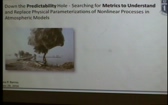Hongqiang Wang : Non-equipartition in a binary granular system and measurement of velocity distribution in a 3D vibrated granular system
- Nonlinear and Complex Systems ( 113 Views )Fluidized granular systems with inelastic inter-particle collisions exhibit distinguishing behavior from it's elastic counterpart. Two species of particles in a binary granular system typically do not have the same mean kinetic energy, in contrast to the equipartition of energy required in equilibrium. It is found that not only the mechanical properties of these two types of particles, but also the heating mechanism plays an important role in affecting the extent of nonequipartition of kinetic energy, even in the bulk of the system. An experimental measurement of the velocity distribution of a 3D vibration fluidized granular medium by spatial resolved high speed video particle tracking is also reported. It is found that the distribution is wider than a Gaussian and broadens continuously with increasing volume fraction.
Karin Dahmen : Unifying theory for tuned-critical quake statistics: from compressed nanopillars to earthquakes
- Nonlinear and Complex Systems ( 97 Views )The deformation of many solid and granular materials is not continuous, but discrete, with intermittent slips similar to earthquakes. A simple model suggests that the statistical distributions of the slips, such as the slip-size distributions, reflect tuned criticality, with approximately the same regular (power-law) functions, and the same tunable exponential cutoffs, for systems spanning 13 decades in length, from tens of nanometers to hundreds of kilometers; for compressed nano-crystals, amorphous materials, possibly sheared granular materials, lab-sized rocks, and earthquakes. The similarities are explained by a simple analytic model, which suggests that results are transferable across scales. This study provides a unified understanding of fundamental properties of shear-induced deformation in systems ranging from nanocrystals to earthquakes. It also provides many new predictions for future experiments and simulations. The studies draw on methods from the theory of phase transitions, the renormalization group, and numerical simulations. Connections to other systems with avalanches, such as magnets and neuron firing avalanches in the brain are also discussed.
Ana Barros : Down the Predictability Hole - Searching for Metrics to Understand and Replace Physical Parameterizations of Nonlinear Processes in Atmospheric Models
- Nonlinear and Complex Systems ( 252 Views )Short-term forecast skill in weather forecasting over the last 15 years has been achieved mostly through data assimilation. Predictive ability however has hit barriers that have not been overcome by increasing computer power and model resolution. Model tuning has come out from hiding, and it is arguably ``trending'' in peer-review over the last 2-3 years. The open question is what (and how) to do next. I will address this question relying on two-decades of research on the representation of moist processes in the atmosphere, specifically targeting the following issues: 1) Evaluating Models to Elucidate the Physics that Matter 2) Detecting and Isolating Sources, Sinks and Barriers of Predictability 3) Meeting the Utility Challenge - Projections vs Predictability
Dezhe Z. Jin : Associative chain as the foundation for action sequence and timing: a case study with birdsong
- Nonlinear and Complex Systems ( 138 Views )Sequence and timing are two fundamental aspects of many critical motor actions that humans and animals must learn and perform. Human speech is a familiar example. How precisely timed action sequences are controlled by networks of neurons, and how such neural networks form through experience, are poorly understood.
Songbirds are excellent animal models for investigating these problems. Male songbirds learn to sing songs with exquisite temporal complexity and precision, similar to human speech. Unlike human brains, songbird brains are experimentally accessible. Indeed, the wealth of experimental data on songbirds makes them ideal systems for computational modeling.
In this talk, I will present a computational study of production and learning of timed action sequence, using birdsong as a concrete example. First, I will advance the idea that associative chains of neurons, also called "synfire chains" in some context, are fundamental building blocks of sequence generating networks. I will show experimental evidence of their existence in the songbird brain, including the recent discovery of a critical property of song controlling neurons, which was predicted by a computational analysis of the robustness of the associative chain dynamics against imperfects in the connectivity and other sources of noise. Second, I will demonstrate computationally that associative chains can form simply through a self-organized process, which depends on ubiquitously observed properties of neurons, including spike-time dependent plasticity of synapses, axonal remodeling, and spontaneous activity. This result suggests that associative chains are stable "attractors" of neural connectivity. The process is robust against death and renewal of neurons, which naturally occur in songbird brain. Finally, I will illustrate that associative chains are also useful for sequence recognition tasks, such as song recognition in songbirds, thus can serve as the neural substrate of sensory-motor integration.
Henry Greenside (hsg@phy.duke.edu) will be the host for his visit.

 yes
yes



